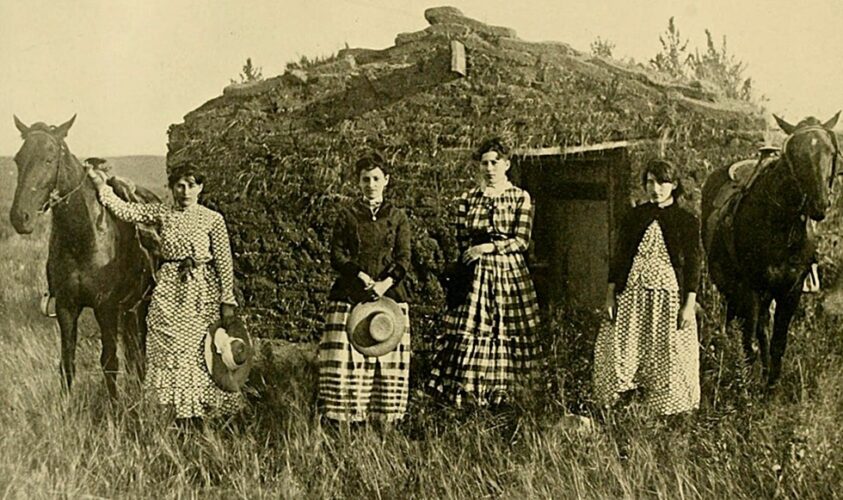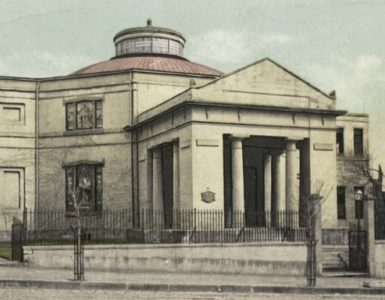 As immigrants settled the United States and its territories in the nineteenth century they tended to gather in colonies according to their common nationalities and associated languages. This is true of the French, Germans, Swiss, Polish, Chinese, and other ethnicities including the Dutch. Gerald De Jong observed in “The Coming of the Dutch to the Dakotas” that in 1870 there were only eight Dutch settlers living among nearly five-thousand foreign born residents in the Dakotas, but just ten years later the Dutch presence had increased significantly due to their establishment of colonies. Advertising by the American railroads in Holland had promoted the Dakotas for farming, but letters from family members describing the benefits of their new homeland were especially appealing to their kin back home. By 1920 thirty-five percent of more than thirty-two hundred Dutch settlers born in Holland were living in the abutting counties of Charles Mix, Douglas and Bon Homme in South Dakota. The total does not include the hundreds of children born to Dutch residents in the region. Author Donald Vedders in Dakota Dawn: One woman’s struggle to survive on a South Dakota homestead, 2025, developed his fictional story of Dutch settlement from the facts he heard during early childhood while sitting with his brothers around their grandfather’s chair as he recounted their ancestors’ pioneer experiences. These sessions with grandfather occurred on Sunday after worshipping God at church as these Dutch Reformed Christians rested from their labors. The author is retired from a medical profession and lives in Greenville, South Carolina.
As immigrants settled the United States and its territories in the nineteenth century they tended to gather in colonies according to their common nationalities and associated languages. This is true of the French, Germans, Swiss, Polish, Chinese, and other ethnicities including the Dutch. Gerald De Jong observed in “The Coming of the Dutch to the Dakotas” that in 1870 there were only eight Dutch settlers living among nearly five-thousand foreign born residents in the Dakotas, but just ten years later the Dutch presence had increased significantly due to their establishment of colonies. Advertising by the American railroads in Holland had promoted the Dakotas for farming, but letters from family members describing the benefits of their new homeland were especially appealing to their kin back home. By 1920 thirty-five percent of more than thirty-two hundred Dutch settlers born in Holland were living in the abutting counties of Charles Mix, Douglas and Bon Homme in South Dakota. The total does not include the hundreds of children born to Dutch residents in the region. Author Donald Vedders in Dakota Dawn: One woman’s struggle to survive on a South Dakota homestead, 2025, developed his fictional story of Dutch settlement from the facts he heard during early childhood while sitting with his brothers around their grandfather’s chair as he recounted their ancestors’ pioneer experiences. These sessions with grandfather occurred on Sunday after worshipping God at church as these Dutch Reformed Christians rested from their labors. The author is retired from a medical profession and lives in Greenville, South Carolina.
The author’s story recounts how Hendrick and Alice Vedders, their children, and their livestock travelled to the Dakotas from Iowa settling in New Holland, Douglas County, with all their worldly goods including a cast-iron stove for heat and a plow for busting prairie sod to prepare for planting. They soon learned that plowing after a good rain would significantly ease the path of the plow’s moldboard through the tenacious sod. As they prospered their farming was made more efficient by purchasing McCormick manufactured harvesting equipment. The tough sod they found to be so challenging to plow became durable building material for their home.
Following six days of labor the Vedders rested on Sunday and worshipped as led by Dominee Van Sant who followed a simple liturgy: singing Psalms, reading the Law, then there was a congregational prayer followed by reading the sermon, and finally the service was concluded with the doxology. The day continued at the family’s home with dinner, Bible reading, and playing a game called “Who am I?” that involved a leader presenting a series of clues about a Bible personality until one of the children made the appropriate identification, and so on.
Life was challenging between scorching, unrelenting heat, and bone-chilling cold that was often accompanied by mighty winds and heavy snow such as occurred in the historic Blizzard of 1886. Maybe the Dutch were particularly suited for such challenges from their Creator given that they have been holding back the North Sea for centuries with dikes to provide additional land for farming. The author’s narrative tells of births, marriages, and deaths as the settlers struggled to survive in their Dakota homeland and of their growing friendship with and help from an Indian whom the author named Two Moons.
One important aspect of Alice Vedders’ life was the book of Psalms. Her parents died when she was but four years old, however, to provide remembrance of her mother she was given her Bible. Alice found comfort and encouragement from not only reading the Bible but also from her mother’s annotations that were often found in the book of Psalms. Alice found Psalms 1, 4, 23, 36, 88, and 116 particularly encouraging and comforting. Undoubtedly, her familiarity with Psalms was due to years of, as was noted earlier in this review, singing them in worship.
Donald Vedders has provided a work of historical fiction that is beneficial for readers of all ages. He has taken a handful of family facts learned at his grandfather’s knee and created believable characters who worked through difficulties and persevered by prayer, Scripture, and worship.
The book is not an account of rugged individuals gritting their teeth and conquering all odds, rather it is the story of worshipping Christians working hard and persevering to subdue creation while directed by prayer, providence, and the grace of God.
Barry Waugh
Notes—The header is provided to give a sense of the challenging simplicity of prairie life; it is not from Vedders’ book but is instead from Sod Houses or the Development of the Great American Plains, by S. D. Butcher, 1904. The reviewer read the eBook version of Dakota Dawn but a paperback edition is also available. Gerald F. De Jong’s article, “The Coming of the Dutch to the Dakotas,” was published in South Dakota History 5:1 (Dec. 1974), pages 20-51; this was located online for free download. He also published The Dutch in America, 1609-1974, Boston: Twayne Publishers, 1975. De Jong taught at the University of South Dakota. The era of Vedders’ book is similar to that of Laura Ingles Wilder whose story is told in Pamela Smith Hill’s book, Pioneer Girl: The Annotated Autobiography, Laura Ingalls Wilder, 2014.




